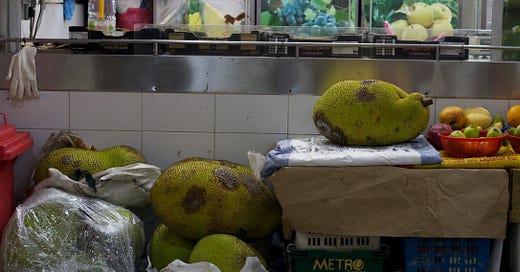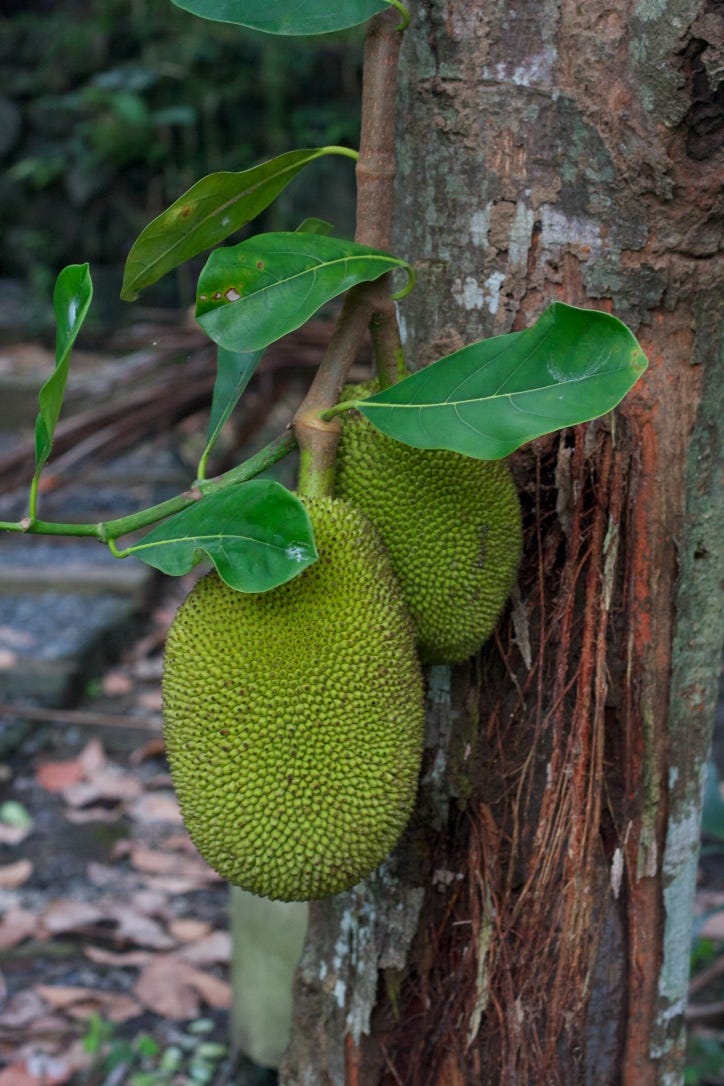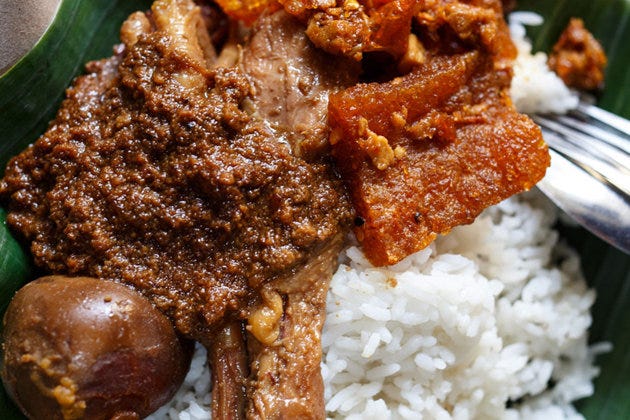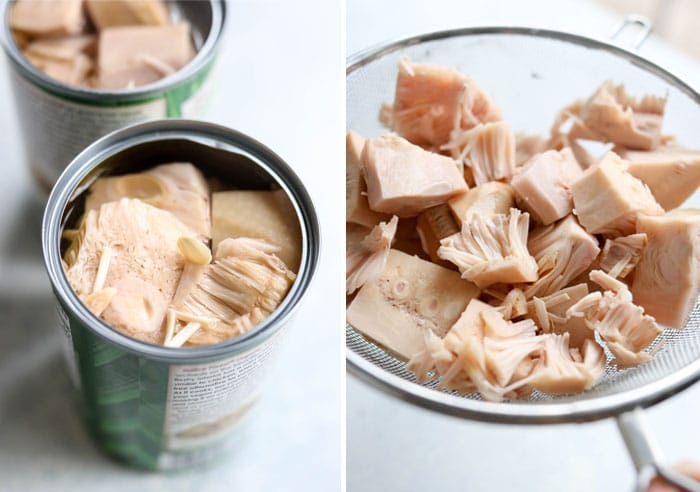On young jackfruit
I first tasted young jackfruit when I was working at Candlenut. While familiar with the highly perfumed ripe fruit, I hardly encountered it in its unripe form. We had a supplier who would bring us produce from Tekka market, and it arrived from the market as uniformly cut, white chunks. Young jackfruit has notoriously sticky sap, so hands had to be greased thoroughly when handling it. We would cook it in water until it was tender, transforming it from something that was far too resinous and tannic to eat raw, to a vegetable that was tender to the tip of the knife.
Young jackfruit has been getting a lot of love in recent times, particularly from the vegetarian/ vegan community, for its resemblance to pulled pork, and the fact that it is a whole food meat substitute, rather than being fashioned out of wheat or soy. When I look up recipes on young jackfruit, the top hits on the internet seem to be all about BBQ jackfruit, as a meatless replacement for Texan-style pulled pork… The difficulty in finding a wide range of recipes written in English for young jackfruit is bizarre because young jackfruit has been, in fact, a part of Asian food culture for centuries. It is not uncommon to see jackfruit trees in people’s homes in Asia. They can be prolific, thriving in even neglected conditions, and when the fruit clusters get too crowded, the young fruit are picked, allowing the rest to continue to ripen.
It is said that India is the origin of jackfruit; its name comes from Portuguese jaca, which in turn is derived from Malayalam term chakka, when the Portuguese arrived in India in 1499. It is so engrained in the local food culture that it finds its way into common parlance. In Kannada, whenever jackfruits and mangoes are in season, people say: hasidu halasu tinnu, undu maavu tinnu, which implies eating jackfruit when hungry, and rounding off your meal with mango when full.
While mature jackfruit is eaten out of hand like a fruit or incorporated into a multitude of desserts, young jackfruit is enjoyed like a vegetable, where it finds its way into biryani, curries, stews, stir-fries, and fritters. Some regions in India even flatten mashed young jackfruit like a tortilla to make pappadums! The seeds are also enjoyed (my Indian grocer stocks the seeds separately in the frozen section), and the leaves are put to use as edible vessels or wraps to steam idlis in!
In Bengal, young jackfruit is known as gaach patha (“tree goat”) for its ability to absorb flavours of the masalas it cooks in. It also referred to as Brahmin’s meat – or meat for the upper-class, comprising priests, teachers, and religious scholars.
Still, in many parts of Asia, people generally don’t look at a young jackfruit and think ‘meat substitute’. It is simply viewed as another vegetable, and can feature in dishes in tandem with meat and seafood. In Javanese cooking, jackfruit is braised for hours with coconut milk and bay leaf, and is served with rice, eggs, chicken and buffalo skin as gudeg. In Thailand, young jackfruit is combined with minced pork and pork rinds in a northern Thai dry curry known as tam khanun. In the Philippines, where jackfruit is known as langka, jackfruit is simmered with coconut milk with shrimp, pork or dried fish.
In Singapore, jackfruit is available at the markets in both its ripe and unripe forms, often as lobes in styrofoam boxes for the former, or in chunks packaged in plastic for the latter (often at Tekka market). Overseas, it is far more common to find the unripe fruit, sold canned in brine. Some notes on cooking and enjoying with young jackfruit:
I find that, once brined, canned jackfruit meat tends to have a noticeable tang, so I like using it in dishes that can benefit from the acidity. Biryani is a good one because you’d typically marinate meat in yogurt in preparation of the dish, so the tang from young jackfruit is neither surprising nor unwelcome.
Canned jackfruit tends to be already cooked so it doesn’t require as lengthy a cooking time as fresh young jackfruit - the cooking is mainly to push flavour into the canned jackfruit.
Young jackfruit is bland like tofu, so it benefits from being cooked with really assertive flavours.
Marinating and deep-frying jackfruit before braising is such a great way to add more flavour to the dish. When deep-frying canned jackfruit, I find it important to sponge off excess liquid with a kitchen towel, or coat in flour.
Manage your own expectations! I am a meat lover and I can tell you that jackfruit does not taste like meat, being quite neutral in flavour. The texture is also rather different, apart from the fact that it shreds easily. Embrace it like a vegetable that is unique and delicious in its own right and you won’t be disappointed :-)
To access all the recipes on the site, sign up to join Singapore Noodles as a member at S$8 per month (even less if you sign up for a year). With that, you’ll be supporting the documentation of Singaporean food culture on the platform. To those of you who have already subscribed, thank you for keeping Singapore Noodles going! This month, we would be cooking Hakka radish balls together, click here to register (members only) 🥰✨








